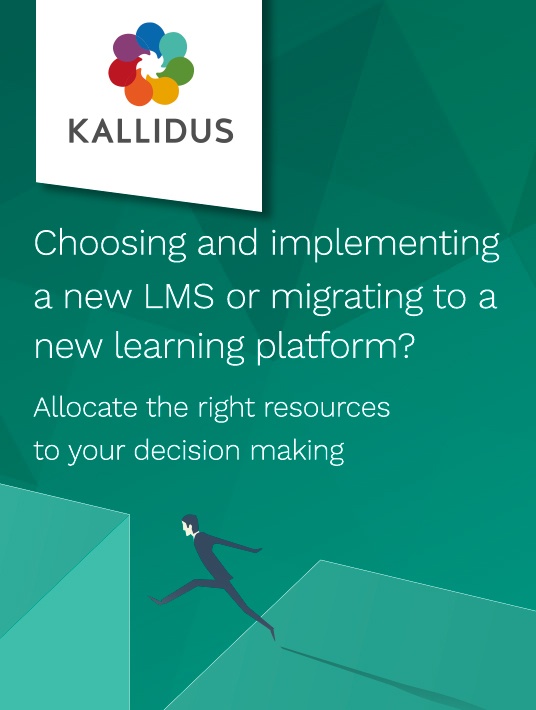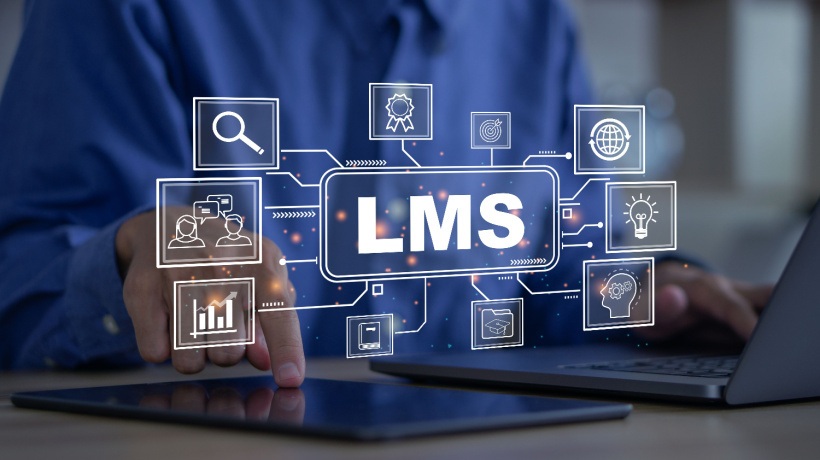The Challenges Associated With Choosing And Implementing An LMS
A recent study found that 48% of organisations are looking for a new or different learning technology [1]. If implementing an LMS is a top priority for your organization, once you’ve researched the options and shortlisted your preferences, take your preferred vendors’ implementation schemes into account – choosing the best LMS is not an assurance of success in itself.

Whether you are implementing a new LMS from scratch or simply migrating to a new learning platform, ensure you allocate the right resources to each stage of the process. Without sufficient planning, the ability to deliver meaningful learning experiences will be difficult.
There is a number of things to consider when looking at a potential LMS for your organisation.
This includes:
- Default “bells and whistles” – do you actually need them, or are you spending over the odds for these defaults, spending more time implementing this complex option and spending even more time removing them?
- What are your core objectives – will the LMS fulfil these core objectives for business benefit, or will it be all-singing-and-dancing, but actually, unusable?
- How many users will be using your system to begin with, and is there room for organisation growth in the future? Is your LMS scalable for employee growth? A large organisation will have different requirements from that of a small organisation – but think ahead for the next five years. Your organisation may only have 50 employees to date, but how much growth would you like to see in the next five years? Your LMS may be able to grow with you if this is taken into account during the early days of planning.
Also consider your organisation’s infrastructure. The system should be able to deliver content at speed regardless of your bandwidth—however, if a potential vendor’s system appears to struggle, you’d be wise to stay away—learning modules need to be quick and accessible, and nothing will turn off your learners more than buffering videos and slow page loads. Make the most of demonstration offerings; see how the system functions in real-time and how this could be applicable to your specific organisation.
How Will You Engage Your Learners?
Once you have decided on your objectives and how your LMS should support them, consider the channels that you wish to use to engage your users – what is the fundamental thing you are looking to improve: compliance? engagement? culture shift? Whilst social aspects may be attention drawing, decide what needs to be improved first, and what will need to be improved in the future as your organisation grows, focusing on how your potential solutions address these needs. Implementing and monitoring your LMS, particularly in its early days, will require resource so decide how best to spend time without affecting your daily workflow.
Focus on what you are trying to achieve and what the business pain is rather than the feature you think is going to solve it. If you approach the vendors with your business pains and objectives rather than a pre-conceived idea of what features your need, you will get more insight into the innovation and experience of the company rather than going through a tick-box of “must-have” requirements, which may not actually help you solve your overall objective. Once you have shortlisted your preferred vendors, speak to your stakeholders.
Your preferred LMS may not withstand IT penetration testing for security reasons; HR may have gripes with its aesthetics; L&D may struggle with its limited content; and Operations may be reluctant to use employees’ data in this way. Having gathered their concerns, go back to your preferred vendors. Experienced vendors should be familiar with your concerns, and be able to show clear examples of how they have helped similar organisations with similar concerns.
Top Tip: Ask to peek inside Have someone with good technical understanding when talking to a vendor, and include HR and Procurement during initial conversations. Ask to see the backend of the system – beauty is as beauty does!
Introducing Your LMS To Your Workforce
Firstly, consider who will take ownership of your LMS: will it be IT, HR, Operations, or L&D?
If no one takes ownership for the system, it is more likely to run amok as no one can take responsibility. Consider team turnover – if the original implementer-owner leaves the organisation, they take with them their working knowledge of the system. If there is opportunity for a handover procedure with their role replacement – can their replacement automatically inherit the personal data saved within the system?
Ownership can encompass many factors, including the initial cost, maintenance costs, implementation, and the day-to-day running of the system. It is crucial for one team to take ownership of these responsibilities, but with it, consider each potential owner’s invested interest in the LMS. Also account for the potential owners’ available resource. Will your system’s owner have time to look after and grow the system? With complexity comes further steps, which can be more time consuming or require a greater skillset. IT may prioritise the system’s overall functionality, its accessibility for remote working, and the security of the system.
HR teams, however, may give precedence to the system’s front end aesthetics; they will be considering what the end user—the learners—will be looking at. They may also focus on the system’s reporting functionality. Reporting takes a huge amount of administrative time for HR teams, and online LMSs can automate reporting to reduce the time spent on manually manipulating data. Ideally, L&D teams should take ownership for the system, supported by IT and HR – L&D teams will be aware of their requirements in terms of updating and administering the system, whilst also recognising their learners’ needs.
Back It Up
However, there is one factor that is often underestimated by all teams during the initial conversations of implementation: administration. This is a broad subject that not only includes the ease of administering the system itself, but also who should administer the system, and how the system should be administered. It is worth noting that IT teams generally have little understanding of an aesthetic user experience, whilst HR teams generally have little systems experience. L&D teams should cultivate a broader understanding of both. The backend of an LMS should be considered during the initial conversations when the front end is seen – after all, it is your team that will be updating and amending the system, and in order to do so, the backend should be easy to use and in line with support from the vendor’s support desk.
Ideally, your LMS provider should have spent as much time developing a functional backend as they have spent developing an aesthetic front end with user experience at the forefront of consideration. Clashes between the Head of L&D and the administrator of the system should be expected in the initial stages due to differing interests – the administrator may find that some requests are impossible to submit into the system due to its functionality. This can be minimised by sharing your internal processes during the procurement stage and inviting your potential vendors to demonstrate how their system will mimic or even improve on these.
A 2017 study found that nearly two-thirds of companies have either a poorly defined learning technology strategy, or worse, no strategy at all[2]. This can cause countless issues throughout the implementation process, so by passing the ownership of the system onto one particular team, you can ensure that the project’s objectives and end goal remain consistent throughout.
Online Vs. Offline
You may decide to remove classroom-based training entirely from your training syllabus, or you may opt to merge online training with classroom-based training for a holistic and rounded learning approach. Whatever your approach, remind yourself of the benefits of online training compared to that of classroom-based training: online LMSs are scalable and won’t be affected by a growing workforce. Classroom-based training is disadvantaged due to the lack of physical space available to cater to all your learners, as well as being costly. Furthermore, it can be difficult to capture all of your new joiners for scheduled classroom compliance training. Instead, new joiners can complete compulsory training during their induction week if the process is taken online.
Online training systems also have the further advantage of engaging learners in ways in which the classroom cannot. Using multi-media content allows learners to remain focused in their training courses, enhancing engagement and providing a topic of conversation amongst colleagues. Whichever approach you decide on, your LMS should support your strategy to ensure you have a seamless approach to all channels and can report holistically. An online LMS will allow you to record all training regardless of its delivery, aiding in the reporting of training and development over the course of the year. This will not only help compliance matters, but build skillsets across the business to ensure that employees are sufficiently trained for their roles within the organisation.
Connecting A Disparate Workforce
Large organisations are more likely to have a disparate workforce, with a range of invested interests, priorities, and skillsets, alongside a breadth of technologies. This said, SMEs are increasingly employing a disparate workforce with the popularity of remote working on the rise. Due to this, any enterprise must ensure that the LMS they opt to implement can support every browser and device available. If you use VPN or Citrix, or prefer your employees to use Internet Explorer or Google Chrome, the LMS’s usability could be affected if it is not optimised for all computer systems devices.
This will require your LMS provider to have tested their product thoroughly and honestly. They should ensure that their product has the functionality to work as expected on all computer systems, and may further require the support of your internal IT team. Your IT team should collaborate with your chosen LMS provider to ensure consistency across supported systems, devices and browsers.
Establish the level of assistance offered with their support desk. Find out if your LMS provider has a troubleshooting document. You will inevitably have issues, particularly in the early days of its use, and if your disparate workforce cannot access the LMS anywhere, anytime, on any device, it is unlikely that they will engage positively or continue to use it.
In our next article, we’ll explore all the ways to achieve success when implementing an LMS. Stay tuned!
References:
[1] Cochran, K. (24 May, 2016). Brandon Hall Group eLearning market trends for 2016: Get more from your learning management system.
[2] Wentworth, D. (31 August, 2017). Satisfaction with learning technology is inextricably linked to strategy and planning










